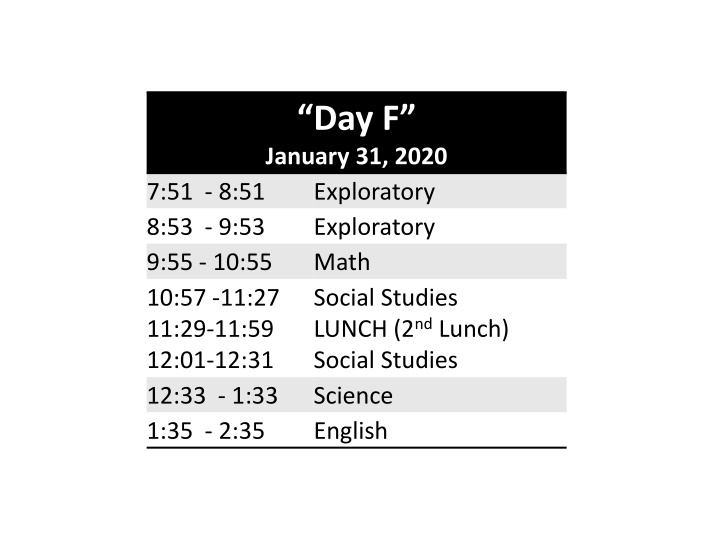
Rectangular Prism Volume Calculation Using Fractions
Learn how to divide fractions to calculate one edge length of a rectangular prism given its volume and other edge lengths. Explore strategies, unit fractions, and alternative methods for finding the volume. Enhance your math skills with practical examples and activities.
Download Presentation

Please find below an Image/Link to download the presentation.
The content on the website is provided AS IS for your information and personal use only. It may not be sold, licensed, or shared on other websites without obtaining consent from the author. If you encounter any issues during the download, it is possible that the publisher has removed the file from their server.
You are allowed to download the files provided on this website for personal or commercial use, subject to the condition that they are used lawfully. All files are the property of their respective owners.
The content on the website is provided AS IS for your information and personal use only. It may not be sold, licensed, or shared on other websites without obtaining consent from the author.
E N D
Presentation Transcript
Day F January 31, 2020 Exploratory Exploratory Math Social Studies LUNCH (2ndLunch) Social Studies 12:33 - 1:33 Science 1:35 - 2:35 English 7:51 - 8:51 8:53 - 9:53 9:55 - 10:55 10:57 -11:27 11:29-11:59 12:01-12:31
Activator (pg. 107): take 2 minutes silent and independent and then you will have 1 minutes to turn and talk to your partners about your solutions.
Possi ble Respo nses.. .
Objective: lesson 15 CONTENT OBJECTIVES: Students will be able to divide fractions to calculate one edge length of a rectangular prism, given its volume and the other two edge lengths and generalize that it takes more smaller cubes or fewer larger cubes to fill the same volume. LANGUAGE OBJECTIVE: Students will explain (orally, in writing, and using other representations) how to solve a problem involving the volume of a rectangular prism with fractional edge lengths. 6.G.A.2
Vocabulary Area Volume
15.2 Cubes with Fractional Edge Lengths pg. 108 Please take 3 minutes of silent think time to answer the questions. Then you will have 3 minutes to turn and talk before we check in as a whole class.
Activity Synthesis Select several students to share their responses and articulate their reasoning. Compare the different strategies students used for finding the volume of the rectangular prism. Ask students: Does it matter which fractional-unit cubes we use to find the volume? Why or why not? (As long as the unit fraction can fit evenly into all three edge lengths of the prism, it doesn t matter what unit fraction we use.) Do certain unit fractions work better as edge lengths of the small cubes than others? (It helps to use as large a unit fraction as possible, since it means using fewer cubes and working with fractions that are closer to 1.) Is there another way of finding the volume of a rectangular prism with fractional edge length besides using these small cubes? (Multiply the fractional edge lengths.) Point out that it is helpful to use a unit fraction that is a common factor of the fractional edge lengths of the prism. Make sure students also recognize that multiplying the edge lengths of the prism is a practical way to find the volume of such a rectangular prism.
How do you feel? topic.
15.3 Fish Tank and Baking Pan (pgs. 109-110) (if time) Please take 3 minutes silent and independent, and then you will have 4 minutes to turn and talk to discuss with your partners.
Activity Synthesis Invite a few students to share their solutions, explanations, and drawings (if any). Record and display their solutions for all to see. To involve more students in the discussion, ask students to indicate whether they agree or disagree with their classmate s reasoning, if they approached it the same way but could explain it differently, or if they have an alternative path.
How do you feel? topic.
Lesson Summary In this lesson, we used fraction multiplication and division to solve several kinds of problems about the volume of rectangular prisms. Consider using this time to help students reflect on their problem-solving process and asking questions such as: How was finding the volume of a prism with fractional edge lengths like finding the volume of a prism with whole-number edge lengths? How is it different? When calculating volume, did you find it harder to work with mixed numbers than with fractions less than 1? Why or why not? (Working with mixed numbers is a little harder since it often involves an extra step of converting them into fractions. If an error is made then, the work that follows is affected. It is easier, however, to make sense of the size of a quantity when it is written as a mixed number.) How was the process of finding an unknown length of a rectangle the same or different than finding an unknown length of a prism? (In both cases, there is one missing factor. When working with area, there are 3 quantities to keep track of: area, base, and height. When working with volume, there are 4 quantities to consider: volume, length, width, and height.) Were there certain parts of calculating a volume or an unknown length that you found challenging or were prone to making mistakes? If so, which parts?
How do you feel? topic.
Homework Pages 113-114
Accommodations Read or reread presentation or activity directions, as needed or after prompting Use examples to model and act as a guide for emerging learners Small group instruction as needed






















